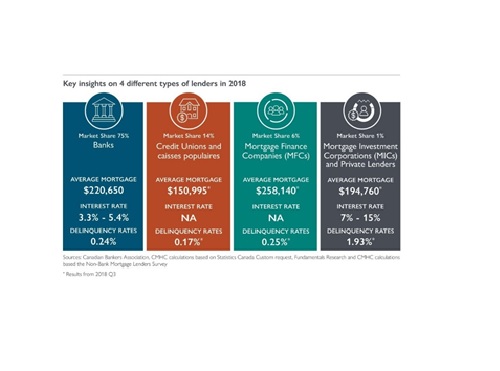A new report from CMHC looks at the state of the Canadian mortgage market and highlights some of the challenges that it faces.
The inaugural Residential Mortgage Industry Report says that recent mortgage regulations, rising interest rates, and softening home sales were factors in a slowing mortgage market in 2018.
It also reveals that the share of uninsured mortgages increased.
Last year saw the slowest year-over-year growth rate of outstanding mortgages in more than 25 years with new mortgages for the purchase of property down 19%, while refinanced mortgages by the same lender decreased by 12%, compared to 2017.
Insured mortgage originations accounted for less than 1 in 3 new mortgage loans in 2018 and, over time, the share of outstanding insured mortgages has decreased by about 16 percentage points from 57% in the first quarter of 2015 to 41% in the same period in 2019.
This increase in uninsured mortgages is the result of adjustments to regulatory changes, of changes in economic conditions and of changes to portfolio insurance, CMHC’s report says.
Lenders and loans
Federally regulated financial institutions (FRFIs) held an estimated 78% of all mortgage debt in 2018 with credit unions holding approximately 14% and mortgage finance companies (MFCs) holding approximately 6%.
Mortgage Investment Corporations (MICs) held an estimated $13-14 billion of mortgages outstanding with their share of mortgage originations more than double their share of the stock, partly due to their increasing market share in the uninsured space.
Fixed-rate 5-year mortgages continued to be the preference of Canadian homebuyers and owners, but variable-rate loans have become more popular with the average share of new mortgages with a variable rate at 29% in the first quarter of 2019, a 12-percentage point increase from the same period in 2017.

Michel Tremblay, Senior Vice-President, Policy and Innovation, Canada Mortgage and Housing Corporation, said that efforts are continuing to fill data gaps across the Canadian housing spectrum as they are identified.
“This new report gathers information from several key initiatives and partnerships including the Non-Bank Mortgage Lender Survey, a Mortgage Investment Corporation (MIC) survey, and our own residential Mortgage data-reporting framework of NHA MBS issuers. The availability of information helps support evidence-based policy and informed decision making within the housing finance sector.”
Mortgage funding trends
- Deposits are the main source of mortgage funding for chartered banks and credit unions. As of the fourth quarter of 2018, the Big Six Banks funded more than 64% of their residential mortgages through deposits, while credit unions used this funding source for more than 3 out of 4 mortgages.
- Covered bonds have gained close to 1-percentage point of the funding market, reaching a record 9.5% in the same period.
- Private securitization such as RMBS and ABCP still account for a very small share of funding sources in Canada, hovering between 0.5% and 1.5%
- CMHC’s funding programs accounted for 30% of all outstanding mortgage credit in Canada at the end of 2018.